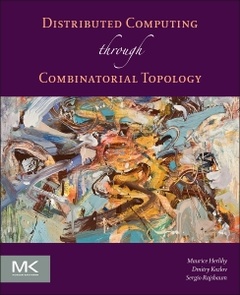Description
Distributed Computing Through Combinatorial Topology
Authors: Herlihy Maurice, Kozlov Dmitry, Rajsbaum Sergio
Language: English
Subjects for Distributed Computing Through Combinatorial Topology:
88.31 €
In Print (Delivery period: 14 days).
Add to cart336 p. · 19x23.3 cm · Paperback
Description
/li>Contents
/li>Readership
/li>Biography
/li>Comment
/li>
Distributed Computing Through Combinatorial Topology describes techniques for analyzing distributed algorithms based on award winning combinatorial topology research. The authors present a solid theoretical foundation relevant to many real systems reliant on parallelism with unpredictable delays, such as multicore microprocessors, wireless networks, distributed systems, and Internet protocols.
Today, a new student or researcher must assemble a collection of scattered conference publications, which are typically terse and commonly use different notations and terminologies. This book provides a self-contained explanation of the mathematics to readers with computer science backgrounds, as well as explaining computer science concepts to readers with backgrounds in applied mathematics. The first section presents mathematical notions and models, including message passing and shared-memory systems, failures, and timing models. The next section presents core concepts in two chapters each: first, proving a simple result that lends itself to examples and pictures that will build up readers' intuition; then generalizing the concept to prove a more sophisticated result. The overall result weaves together and develops the basic concepts of the field, presenting them in a gradual and intuitively appealing way. The book's final section discusses advanced topics typically found in a graduate-level course for those who wish to explore further.
I. Fundamentals1. Introduction2. Two-Process Systems3. Elements of Combinatorial Topology
II. Colorless Tasks4. Colorless Wait-free Computation5. Solvability of Colorless Tasks6. Byzantine Colorless Computation7. Simulations and Reductions
III. General Tasks8. Read-Write Protocols for General Tasks9. Manifold Protocols10. Connectivity11. Wait-Free Computability for General Tasks
IV. Advanced Topics12. Renaiming and Oriented Manifolds13. Task Solvability in Different Communication Models14. Colored Simulations and Reductions15. Classifying Loop Agreement Tasks16. Immediate Snapshot Subdivisions
Grad / undergrad students in CS or Math; as well as working researchers or computer engineers.
Prof. Dmitry Kozlov is recipient of the Wallenberg Prize of the Swedish Mathematics Society (2003), the Gustafsson Prize of the Goran Gustafsson Foundation (2004), and the European Prize in Combinatorics (2005). He has been a Senior Lecturer at the Royal Institute of Technology, Stockholm, and an Assistant Professor at ETH Zurich. Currently he holds the Chair of Algebra and Geometry at the University of Bremen, Germany. He is the author of the book Combinatorial Algebraic Topology published by Springer Verlag in 2008.
Prof. Sergio Rajsbaum is a member of the Institute of Mathematics at UNAM, where he is now a Full Professor. He has spent postdoctoral and sabbatical stays at the Massachusetts Institute of Technology and HP Research Labs. His main research interests are in the theory of distributed computing, and has about 100 publications in prestigious conferences and journals, and has been Program Committee member, and Program Chair of main forums in the area, such as the ACM Principles of Distributed Computing.
- Named a 2013 Notable Computer Book for Computing Methodologies by Computing Reviews
- Gathers knowledge otherwise spread across research and conference papers using consistent notations and a standard approach to facilitate understanding
- Presents unique insights applicable to multiple computing fields, including multicore microprocessors, wireless networks, distributed systems, and Internet protocols
- Synthesizes and distills material into a simple, unified presentation with examples, illustrations, and exercises




